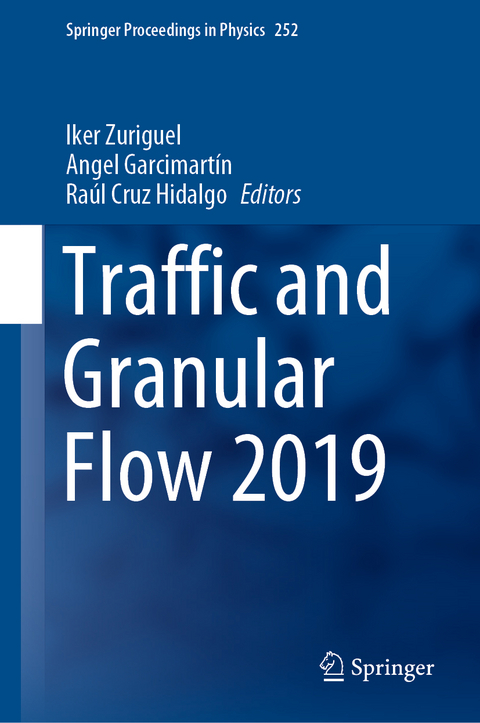
Traffic and Granular Flow 2019
Springer International Publishing (Verlag)
978-3-030-55972-4 (ISBN)
This book gathers contributions on a variety of flowing collective systems. While primarily focusing on pedestrian dynamics, they also reflect the latest developments in areas such as vehicular traffic and granular flows and address related emerging topics such as self-propelled particles, data transport, swarm behavior, intercellular transport, and collective dynamics of biological systems. Combining fundamental research and practical applications in the various fields discussed, the book offers a valuable asset for researchers and practitioners alike.
Part 1: Pedestrian dynamics.- Chapter 1. In uence of Corridor Width and Motivation on Pedestrians in Front of Bottlenecks.- Chapter 2. The Measurement of Stress at Open-Air Events: Monitoring Emotion and Motion Utilizing Wearable Sensor Technology.- Chapter 3. Smoothing trajectories of people's heads.- Chapter 4. In uence of Small-Scale Obstacles on Passenger Flows in Railway Stations.- Chapter 5. Analysis of Pedestrian Motion Using Voronoi Diagrams in Complex Geometries.- Chapter 6. The trouble with 2nd order models or how to generate stop-and-go tra c in a 1st order model.- Chapter 7. The impact of walking speed heterogeneity and ow ratio on the pedestrian fundamental diagram.- Chapter 8. Experimental investigation on information provision methods and guidance strategies for crowd control.- Chapter 9. The impact of guidance information on exit choice behavior during an evacuation - a VR study.- Chapter 10. Experimental study on crowds with di erent velocity composition.- Chapter 11.The e ect of an obstacle before a bottleneck: inert particles, sheep, and persons.- Chapter 12. Towards Inferring Input Parameters from Measurements: Bayesian Inversion for a Bottleneck Scenario.- Chapter 13. Spatially dependent friction - a way of adjusting bottleneck ow in cellular models.- Chapter 14. Experimental study on the congestion-sharing e ect of obstacle on pedestrian crowd egress.- Chapter 15. Experimental setups to observe evasion maneuvers in low and high densities.- Chapter 16. How to change the value of Social Force Model's relaxation time parameter with desired speed such that bottleneck ow remains unchanged.- Chapter 17. An analytical solution of the Social Force Model for uni-directional ow.- Chapter 18. A cognitive, decision-based model for pedestrian dynamics.- Chapter 19. Exploring Koopman Operator Based Surrogate Models - Accelerating the Analysis of Critical Pedestrian Densities.- Chapter 20. Evacuation Characteristics of Students Passing through Bottlenecks. Chapter 21. An e cient crowd density estimation algorithm through network compression.- Chapter 22. Modelling Pedestrian Social Group Passing Strategy with Expression-Matrix and Social Force.- Chapter 23. Pedestrian fundamental diagram in between normal walk and crawling.- Chapter 24. Deep Fundamental Diagram Network for Real-time Pedestrian Dynamics Analysis.- Chapter 25. Data-driven simulation for pedestrian avoiding a fixed obstacle.- Chapter 26. Entropy, Field Theory and Pedestrian Dynamics: Prediction and Forensics.- Chapter 27. The impact of social groups on collective decision-making in evacuations: a simulation study.- Chapter 28. Set-up of a method for people-counting using images from a UAV.- Chapter 29. Modeling of position finding in waiting processes on platforms.- Chapter 30. Exploring the e ect of crowd management measures on passengers' behaviour at metro stations.- Chapter 31. Rotation behaviour of pedestrians in bidirectional and crossing ows.- Chapter 32. Experimental study on one-dimensional movement with di erent motion postures.- Chapter 33. A decision model for pre-evacuation time prediction based on fuzzy logic theory.- Chapter 34. Clogging in velocity-based models for pedestrian dynamics.- Chapter 35. Exit-choice behavior in evacuation through an L-shaped corridor.- Chapter 36. Bidirectional Flow on Stairs at Di erent Flow Ratios.- Chapter 37. Gender profiling of pedestrian dyads.- Chapter 38. The e ect of social groups on the dynamics of bi-directional pedestrian ow: a numerical study.- Chapter 39. Experimental study on pedestrian ow under di erent age groups and movement motivations.- Chapter 40. Experimental Analysis of the Restriction Mechanisms of Queuing on Pedestrian Flow at Bottleneck.- Chapter 41. Vadere - A simulation framework to compare locomotion models.- Part 2: Granular and active matter.- Chapter 42. First-order contributions to the partial temperatures in dilute binary granular suspensions.- Chapter 43. Acoustic resonances in a confined set of disks.- Chapter 44. Morphological response of clogging arches to gentle vibration.
| Erscheinungsdatum | 18.11.2020 |
|---|---|
| Reihe/Serie | Springer Proceedings in Physics |
| Zusatzinfo | XXVII, 611 p. 278 illus., 246 illus. in color. |
| Verlagsort | Cham |
| Sprache | englisch |
| Maße | 155 x 235 mm |
| Gewicht | 1118 g |
| Themenwelt | Naturwissenschaften ► Physik / Astronomie ► Atom- / Kern- / Molekularphysik |
| Naturwissenschaften ► Physik / Astronomie ► Festkörperphysik | |
| Naturwissenschaften ► Physik / Astronomie ► Thermodynamik | |
| Schlagworte | Complex Systems • Conference Proceedings on Traffic and Granular Flow • Granular material • many-body systems • Pedestrian Dynamics • Vehicular traffic |
| ISBN-10 | 3-030-55972-6 / 3030559726 |
| ISBN-13 | 978-3-030-55972-4 / 9783030559724 |
| Zustand | Neuware |
| Haben Sie eine Frage zum Produkt? |
aus dem Bereich


